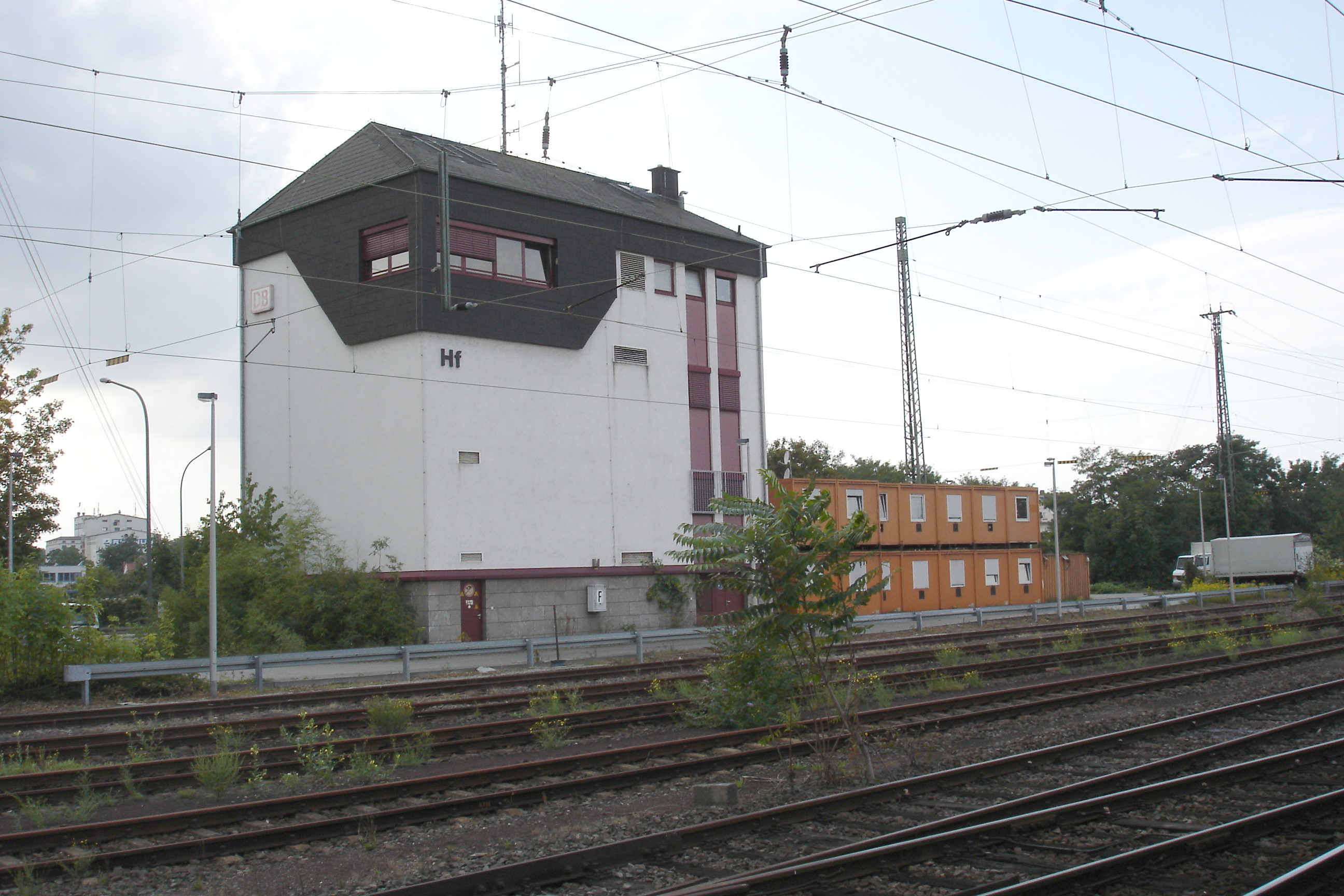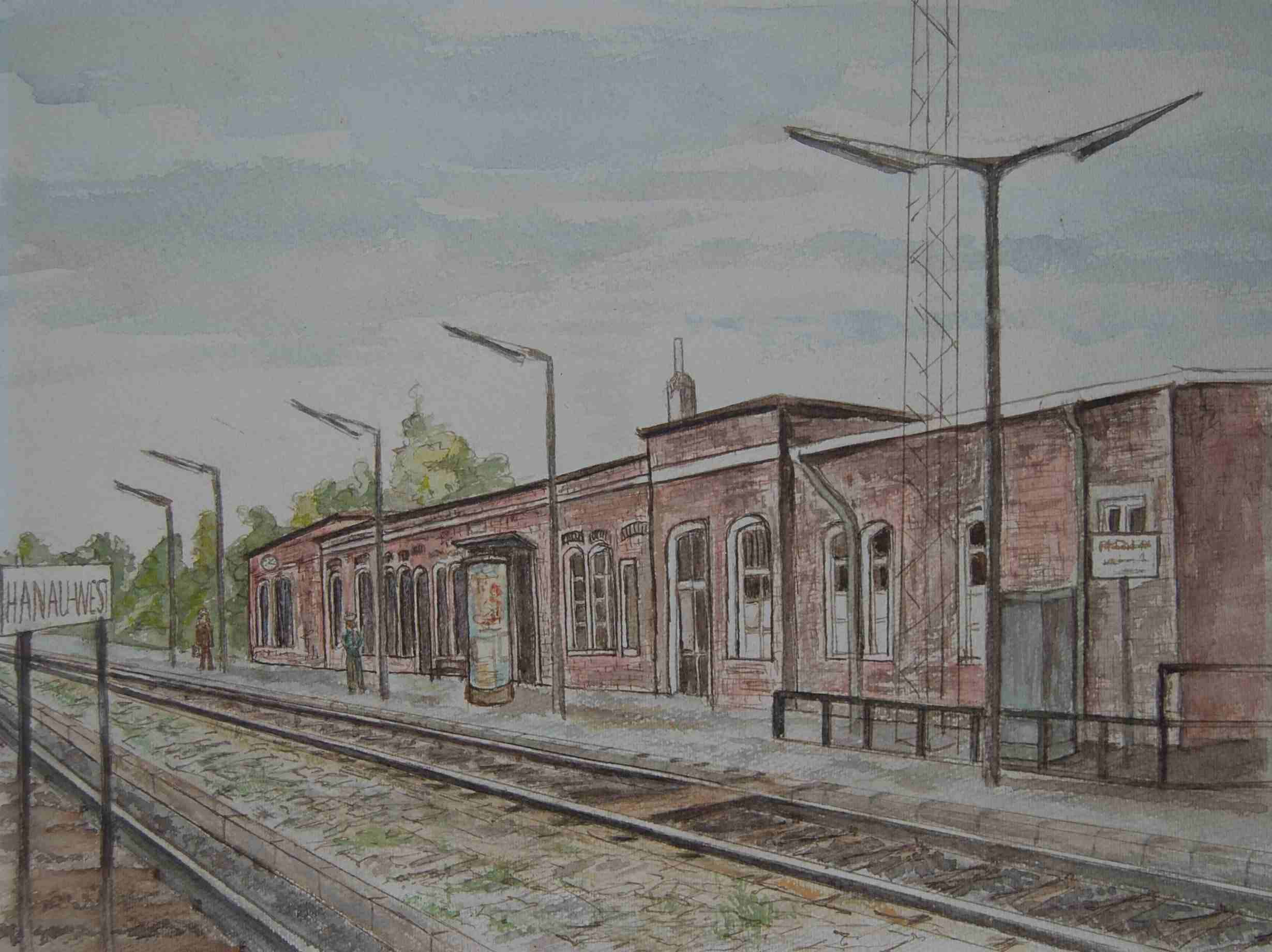|
Hanau Hbf
Hanau Hauptbahnhof is a railway station in Hanau in the German state of Hesse, and is a major railway junction east of Frankfurt am Main. It was opened in 1867, but the current building was built in the late 1960s. It is located about south-east of central Hanau. It is classified by Deutsche Bahn (DB) as a category 2 station and has many train services, including Intercity Express, regional and S-Bahn services. Links Hanau Hauptbahnhof is a central hub of the railway network that is served by six routes. It is served by: * Frankfurt-Hanau Railway (Hanau–Maintal–Frankfurt) * Main-Spessart Railway (Hanau–Kahl–Aschaffenburg) * Frankfurt-Bebra Railway ** towards the east: Kinzig Valley Railway, Hanau–Fulda–Göttingen ** towards the west: Offenbach am Main–Frankfurt am Main, as the South Main S-Bahn * Friedberg–Hanau railway to Friedberg * Odenwald Railway (Hanau–Groß-Umstadt Wiebelsbach–Eberbach) History Today's Hanau Hauptbahnhof was opened on 1 May 1867 ... [...More Info...] [...Related Items...] OR: [Wikipedia] [Google] [Baidu] |
Hanau
Hanau () is a town in the Main-Kinzig-Kreis, in Hesse, Germany. It is located 25 km east of Frankfurt, Frankfurt am Main and is part of the Frankfurt Rhine-Main, Frankfurt Rhine-Main Metropolitan Region. Its Hanau Hauptbahnhof, station is a major railway junction and it has a port on the river Main (river), Main, making it an important transport centre. The town is known for being the birthplace of Brothers Grimm, Jakob and Wilhelm Grimm and Franciscus Sylvius. Since the 16th century it was a centre of precious metal working with many goldsmiths. It is home to Heraeus, one of the largest family-owned companies in Germany. Hanau, once the seat of the Counts of Hanau, lost much of its architectural heritage in World War II. A British air raid in 1945 created a firestorm, killing one sixth of the remaining population and destroying 98 percent of the old city and 80 percent of the city overall. In 1963, the town hosted the third ''Hessentag'' state festival. Until 2005, Hanau wa ... [...More Info...] [...Related Items...] OR: [Wikipedia] [Google] [Baidu] |
Main-Spessart Railway
Main-Spessart is a ''Landkreis'' (district) in the northwest of Bavaria, Germany. It is located in Lower Franconia and derives its name from the river Main and the wooded hills of the Spessart. Geography The district is bounded by (from the north and clockwise) the districts of Bad Kissingen, Schweinfurt and Würzburg, the state of Baden-Württemberg (district of Main-Tauber), the districts of Miltenberg and Aschaffenburg, and the state of Hesse (district of Main-Kinzig). The river Main forms a large horse-shoe bend in the district, entering in the southeast near Thüngersheim and leaving to the southwest near Hasloch. In the north it is joined by the Franconian Saale river at Gemünden. The Spessart hills cover most of the area of the district west and north of the Main. To the northeast, the district borders on the Rhön hills. History The district was established in 1972 by merging the former districts of Gemünden, Karlstadt, Lohr and Marktheidenfeld. Although Lohr is the l ... [...More Info...] [...Related Items...] OR: [Wikipedia] [Google] [Baidu] |
Aschaffenburg Hauptbahnhof
Aschaffenburg Hauptbahnhof is the main station of Aschaffenburg in the German state of Bavaria. It is located on the busy Ruhr– Frankfurt–Nuremberg–Munich/Vienna rail corridor. Deutsche Bahn classifies it as a category 2 station. It forms the boundary between the city centre and the district of Damm. History The passenger station was originally located at the modern marshalling yard, which has been mostly dismantled. The station was opened in 1854 with the commissioning of the Bavarian Ludwig Western Railway (''Ludwigs-West-Bahn'']) on what was then a green field. During the Second World War, the station as a hub represented a target for Allied air raids, including on the night of 1/2 April 1942. The original station building was destroyed in an air raid on the railway facilities on 29 December 1944. In the first half of the 1950s, a new building by Hans Kern was built on the same site in an New Objectivity (architecture), objective style. The entrance hall had a large g ... [...More Info...] [...Related Items...] OR: [Wikipedia] [Google] [Baidu] |
Main (river)
The Main () is the longest tributary of the Rhine. It rises as the White Main in the Fichtel Mountains of northeastern Bavaria and flows west through central Germany for to meet the Rhine below Rüsselsheim, Hesse. The cities of Mainz and Wiesbaden are close to the confluence. The largest cities on the Main are Frankfurt am Main, Offenbach am Main and Würzburg. It is the longest river lying entirely in Germany (if the Weser-Werra are considered separate). Geography The Main flows through the north and north-west of the state of Bavaria then across southern Hesse; against the latter it demarcates a third state, Baden-Württemberg, east and west of Wertheim am Main, the northernmost town of that state. The upper end of its basin opposes that of the Danube where the watershed is recognised by natural biologists, sea salinity studies (and hydrology science more broadly) as the European Watershed. The Main begins near Kulmbach in Franconia at the joining of its two headst ... [...More Info...] [...Related Items...] OR: [Wikipedia] [Google] [Baidu] |
Hanau West Station
Hanau West station is the oldest station in the city of Hanau in the German state of Hesse. It was opened in 1848 and is located on the 17.9 kilometre mark of the Frankfurt Süd–Aschaffenburg railway. Operationally, since the 1970s it has been classified as a ''Haltepunkt'' ("halt"). The station is classified by Deutsche Bahn (DB) as a category 5 station. History The Hanau West station was opened in 1848 as the eastern end and terminus of the Frankfurt-Hanau railway by the Frankfurt-Hanau Railway Company (german: Frankfurt-Hanauer Eisenbahn Gesellschaft, FHE) and was the first station opened in Hanau. It was then on the western edge of Neustadt Hanau (Hanau "new town", a district built from 1597 to house Calvinist refugees from France and the Spanish Netherlands) and was connected directly to Philippsruhe Palace by Philippsruher Allee. The entrance building was designed by the architect Julius Eugen Ruhl, like the station to its immediate west at Wilhelmsbad. The station buil ... [...More Info...] [...Related Items...] OR: [Wikipedia] [Google] [Baidu] |
Frankfurt–Bebra Railway
The Frankfurt–Bebra railway runs from Bebra to Frankfurt am Main via Fulda, Gelnhausen, Hanau and Offenbach am Main in south central Germany. The southern section between Fulda and Frankfurt is known as the Kinzig Valley railway (german: Kinzigtalbahn) due to the route it follows through the Kinzig Valley. This important north–south link was planned by the Electorate of Hesse-Kassel as the ''Bebra–Hanau railway'' but was first opened under Prussian management. This line was extended as far as Frankfurt under the name ''Frankfurt–Bebra railway''. Today it is part of the ''Intercity-Express'' (''ICE'') lines from north and central Germany to Frankfurt. Just as important is the ''Regional-Express'' connexion from Fulda to Frankfurt and the ''Stadt-Express'' link from Wächtersbach to Frankfurt. With the Main–Weser Railway it is one of the most important north–south freight lines in central Germany. History When railways began to be built in Germany in the nineteenth cent ... [...More Info...] [...Related Items...] OR: [Wikipedia] [Google] [Baidu] |
Friedberg Station
Friedberg (Hess) station is the station of Friedberg, Germany, on the Main-Weser Railway. History First station The first Friedberg station was opened on 10 May 1850 with the opening of the section of the Main-Weser Railway from Frankfurt am Main to Friedberg. On 9 November 1850 the next section to Butzbach was opened. The entire route of the Main-Weser line from Kassel to Frankfurt was opened for traffic 15 May 1852. The station was at the 165.4 kilometre mark (from Kassel) and was designed as a through station. There is currently a parking garage on the site of the old station building. Additional lines were connected to the Main-Weser Railway in Friedberg. On 15 September 1881, the Friedberg–Hanau railway was fully opened, following the commencement of services to Heldenbergen-Windecken (now Nidderau) station on 1 December 1879. On 1 October 1897 the Friedberg–Mücke Railway opened. On 13 July 1901 the Friedberg–Friedrichsdorf–Bad Homburg line opened; this was part ... [...More Info...] [...Related Items...] OR: [Wikipedia] [Google] [Baidu] |
Friedberg–Hanau Railway
The Friedberg–Hanau railway is a 32.2 km long double-track, electrified mainline in the German state of Hesse. It connects Friedberg and Hanau. The line has the timetable number of 633 and it is integrated in the Rhein-Main-Verkehrsverbund (Rhine Main Transport Association) as Regionalbahn service RB 49. History The line was authorised under an act of the Prussian parliament of 11 June 1873 and opened by the Prussian state railways in two phases. The first section was opened from Hanau to Heldenbergen-Windecken (now Nidderau) on 1 December 1879. The second section opened from Heldenbergen-Windecken to Friedberg for freight on 15 September 1881 and for passenger traffic on 15 October 1881. Significance The importance of the route lies in freight traffic. It forms part of a trunk route from the Ruhr region to Bavaria via the Ruhr–Sieg railway, the Dill Railway and the Main–Weser Railway from Giessen to Friedberg via and continuing from Hanau via the Main–Spessart Rai ... [...More Info...] [...Related Items...] OR: [Wikipedia] [Google] [Baidu] |
South Main S-Bahn
South is one of the cardinal directions or compass points. The direction is the opposite of north and is perpendicular to both east and west. Etymology The word ''south'' comes from Old English ''sūþ'', from earlier Proto-Germanic ''*sunþaz'' ("south"), possibly related to the same Proto-Indo-European root that the word ''sun'' derived from. Some languages describe south in the same way, from the fact that it is the direction of the sun at noon (in the Northern Hemisphere), like Latin meridies 'noon, south' (from medius 'middle' + dies 'day', cf English meridional), while others describe south as the right-hand side of the rising sun, like Biblical Hebrew תֵּימָן teiman 'south' from יָמִין yamin 'right', Aramaic תַּימנַא taymna from יָמִין yamin 'right' and Syriac ܬܰܝܡܢܳܐ taymna from ܝܰܡܝܺܢܳܐ yamina (hence the name of Yemen, the land to the south/right of the Levant). Navigation By convention, the ''bottom or down-facing side'' of a ... [...More Info...] [...Related Items...] OR: [Wikipedia] [Google] [Baidu] |
Offenbach Am Main
Offenbach am Main () is a List of cities and towns in Germany, city in Hesse, Germany, on the left bank of the river Main (river), Main. It borders Frankfurt and is part of the Frankfurt urban area and the larger Frankfurt Rhein-Main Regional Authority, Frankfurt Rhein-Main urban area. It has a population of 138,335 (December 2018). In the 20th century, the city's economy was built on machine-building, leather-making, typography and design, and the automobile and pharmaceutical industries. Geography Subdivision The inner city area of Offenbach is quite large and consists of the historic center of the city and its expansions of the 1800s. Three formerly independent suburbs were incorporated in the first half of the 20th century: Offenbach-Bürgel, Bürgel being the first in 1908, then Offenbach-Bieber, Bieber and Offenbach-Rumpenheim, Rumpenheim in 1938 and 1942. South of the inner city area are the suburbs Offenbach-Lauterborn, Lauterborn, Offenbach-Rosenhöhe, Rosenhöhe and Te ... [...More Info...] [...Related Items...] OR: [Wikipedia] [Google] [Baidu] |






.jpg)